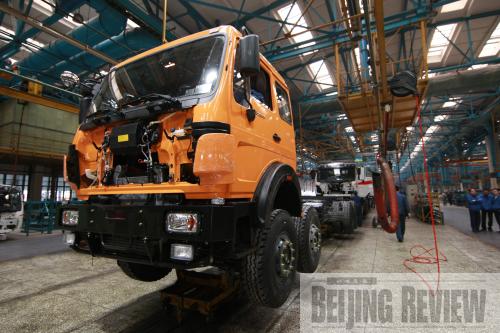|
 |
|
START YOUR ENGINES: Production has gradually recovered since late January 2009 at the Inner Mongolia First Machinery Group, which was hit by the financial crisis (WANG HAO) |
North China's Inner Mongolia Autonomous Region's development is progressing comparatively fast, though there is still a long way to go until it catches up with advances being made in other parts of China, officials said. Still, the numbers for the largely undeveloped area are impressive.
 |
|
"Nine out of every 10 bulbs in Beijing are lit with Inner Mongolian electricity." --Ren Yaping | "As a key national base for energy and raw materials, the gross domestic product (GDP) of Inner Mongolia is expected to grow by 13 percent in 2009 in spite of the global financial crisis," said Ren Yaping, Executive Vice Chairman of Inner Mongolia Autonomous Region.
From 2002 to 2008, Inner Mongolia's economic growth rate ranked first among 31 provinces, municipalities and autonomous regions. In 2008, GDP growth reached 17.2 percent in the region, 8.2 percentage points higher than the country's average. And in the first quarter of 2009, Inner Mongolia's expansion still reached 15.8 percent, over twice as high as the nation's 6.1 percent quarterly growth.
Still, Ren said, Inner Mongolia's explosive growth needs to be put in perspective, as the area started from a weak foundation. Neither its total economic output nor the income of its rural and urban residents has reached the national average yet. In 2008, Inner Mongolia's total output for the whole year equaled that of just the first quarter of 2009 in south China's Guangdong Province.
Image building
Inner Mongolia occupies 1.18 million square km, one eighth of the country's landmass, with a population of about 24 million. It is a large area with a small population that holds many ethnic groups.
Most people know it for its vast prairies and cattle and sheep herds that have been the subject of many poems. Inner Mongolia relies mainly on agriculture and animal husbandry. The average Inner Mongolian holds 0.36 hectares of cultivated land, four times that of the rest of the nation. It produces the most milk and cashmere in the country.
As the economy has developed, however, the environment has suffered. Inner Mongolia has become synonymous with desertification in recent years, and its sand frequently blows into Beijing. This has become a major concern and triggered government action at all levels, focusing the public on a major anti-desertification campaign. Through implementing forestry and ecological mitigation projects, the environment has improved since 2006.
"In the past 10 years, Inner Mongolia has invested 40 billion yuan ($5.86 billion) in ecological construction, which is a big number for an undeveloped region," said Ren.
Meanwhile, the region also grasps every opportunity to develop the economy by transforming from an agricultural society to one of industrialization and urbanization, said Ren.
Rich resources
According to official data current to 2007, Inner Mongolia holds 13 oil-gas fields with expected oil reserves of as much as 3 billion tons, proved natural gas deposits equal to 1 trillion cubic meters and coal deposits of 223.4 billion tons, which exceeds that of coal-rich Shanxi Province. In 2008, Inner Mongolia's raw coal output reached 470 million tons, ranking it second in the country.
Ordos City, located in southwest Inner Mongolia, is the main coal production area of the region, with deposits totaling 167.6 billion tons, one sixth of the total production of the whole country. The booming coal industry there has allowed Ordos to develop into the most prosperous area of Inner Mongolia. Baotou City, next to Ordos, is another prosperous area. It is an old industrial city that has up to 90 percent of China's deposits of rare earth metals, which are used in glass making and ceramics.
Ordos, Baotou and Hohhot, capital of Inner Mongolia, are called the region's "Golden Triangle." The economic output of the triangle accounts for almost half of Inner Mongolia's total output.
Power generation is another industry feeding the prosperity of Inner Mongolia. The region has reached a capacity of 50 million kw, ranking it at the top in China and providing electricity to other provinces and regions. "Nine out of every 10 bulbs in Beijing are lit with Inner Mongolian electricity," said Ren.
China has implemented regional development strategies in the undeveloped west and north of the country that were first deployed in northeast China. "It is a very good opportunity for the development of Inner Mongolia," said Ren.
Ren said that cooperation with Russia to its north has also fueled the development of Inner Mongolia in recent years.
Slow recovery
In September 2008, Inner Mongolia's industrial output increased by 28.7 percent, according to data from the Development and Reform Commission of Inner Mongolia Autonomous Region. In October that rate dropped to 20.3 percent and in December expansion slowed to only 3.6 percent. This was the same period in which the global financial crisis spread into China.
With a series of remedial policies, the local economy has been gradually growing in 2009. Data from the Inner Mongolia Bureau of Statistics show that first quarter 2009 GDP grew 15 percent over the same period last year. It was also 0.6 percentage point higher than the last quarter of 2008, which shows that the Inner Mongolian economy is trending upward.
There are other signs of recovery. The Inner Mongolia First Machinery Group Corp., located in Baotou, is a company that produces heavy-duty trucks, rail vehicles and construction machinery. This company, like the rest of the automotive industry, has been severely impacted by the financial crisis.
"Due to the financial crisis, in December 2008, we stopped some of the production lines and reduced production of heavy-duty trucks by 40 percent," said Bai Xiaoguang, General Manager of the company. "With the adjustment of the product structure and more market research, business has been gradually recovering since January 2009. Up to March, we have produced 3,800 vehicles, a monthly production record for the company."
Compared with local companies, some foreign-funded enterprises in Inner Mongolia have been hit harder. The Inner Mongolia Sunnergy Co. Ltd., founded in January 2006, is the first hi-tech foreign-funded company to enter Inner Mongolia. A producer of silicon, the company's sales volume reached 800 million yuan ($117 million) in 2008.
But the company's founder, Zhou Jian, said that his main market is in some European countries, which have been hit hard by the global financial crisis. As a result, his sales have fallen off.
"We experienced the hardest times in January and February of 2009, when we had almost no orders," said Zhou.
Fortunately, in March the company picked up several big orders, which kicked the equipment that had been lying idle into action again.
"It is estimated that through July this year, with more orders coming in, the sales volume of the company will rebound sharply," said Zhou. | 